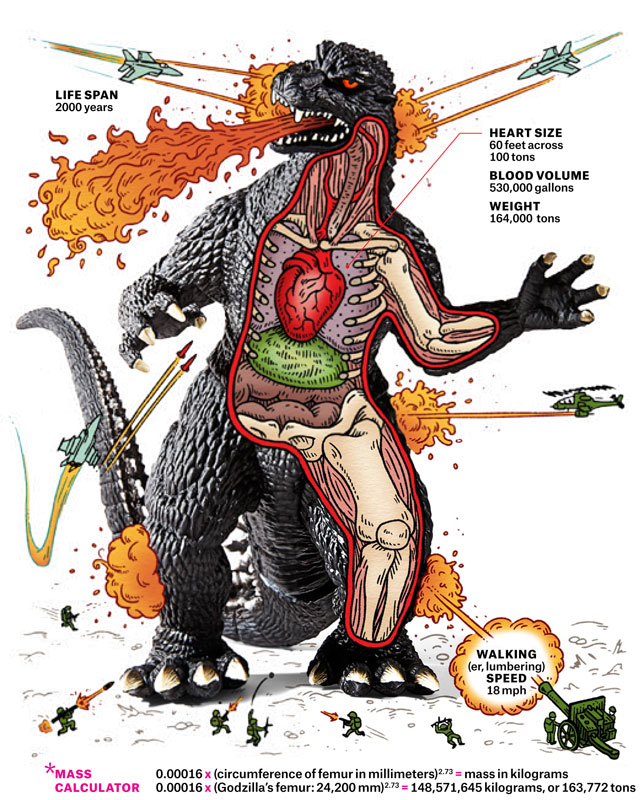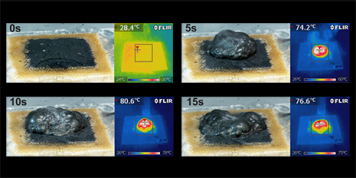Friday, May 16, 2014
Friday links
Au Bon Pain is being sued for $2 undecillion (which is a 2 followed by 36 zeros). What if they lose and have to pay?
Operation Margarine: Tracing the wartime rise of ersatz butter.
Mathematics Of Murder, Autonomous Cars and Robotic Soldiers: Should A Robot Sacrifice Your Life To Save Two?
ICYMI, Thursday's links are here, and include the reason red M&Ms disappeared for a decade, calculating Star Trek's Tribble problem, pain management via orgasm, and impossible Godzilla anatomy.
Thursday, May 15, 2014
Mathematics Of Murder, Autonomous Cars and Robotic Soldiers: Should A Robot Sacrifice Your Life To Save Two?
It happens quickly—more quickly than you, being human, can fully process.
A front tire blows, and your autonomous SUV swerves. But rather than veering left, into the opposing lane of traffic, the robotic vehicle steers right. Brakes engage, the system tries to correct itself, but there’s too much momentum. Like a cornball stunt in a bad action movie, you are over the cliff, in free fall.
Your robot, the one you paid good money for, has chosen to kill you. Better that, its collision-response algorithms decided, than a high-speed, head-on collision with a smaller, non-robotic compact. There were two people in that car, to your one. The math couldn’t be simpler.
That's the beginning of a PopSci article discussing a recent opinion piece at Wired on one of the most disturbing questions in robot ethics: If a crash is unavoidable, should an autonomous car choose who it slams into?
Here's a second robotic scenario, in combat:
A group of soldiers has wandered into the kill box. That’s the GPS-designated area within which an autonomous military ground robot has been given clearance to engage any and all targets. The machine’s sensors calculate wind-speed, humidity, and barometric pressure. Then it goes to work.
 |
| Boston Dynamics' Atlas robot - video below |
The shots land cleanly, for the most part. All of the targets are down.
But only one of them is in immediate mortal danger—instead of suffering a leg wound, like the rest, he took a round to the abdomen. Even a robot’s aim isn’t perfect.
As with the autonomous car crash scenario, everything hinges on that level of technological certainty. A human soldier or police officer isn’t legally or ethically expected to aim for a target’s leg. Accuracy, at any range or skill level, is never a sure thing for mere mortals, much less ones full of adrenaline.
But if it’s possible to build that level of precision into a machine, expectations would invariably change. A manufacturer may be able to program systems to cripple targets instead of executing them. But if that’s the clear choice—that robots should actively reduce human deaths, even among the enemy—wouldn’t you have to accept that your car has killed you, instead of two strangers?
The Department of Defense issued a Directive in 2013 titled “Autonomy in Weapons Systems”—another sign of how seriously the military is taking this. Among other things, it “Establishes guidelines designed to minimize[emphasis added] the probability and consequences of failures in autonomous and semi-autonomous weapon systems that could lead to unintended engagements.” But the directive also requires that the robots will “Function as anticipated in realistic operational environments against adaptive adversaries.”
Plus this:Coping with “adaptive adversaries” implies at least a degree of autonomy—and that is a discomforting notion for some.
DARPA—the Defense Advanced Research Projects Agency—has been actively funding robot research for years and this past summer showcased “one of the most advanced humanoid robots ever built”: a stocky 6’ 2” behemoth of a bot named “Atlas.” Its creators at Boston Dynamics (a company recently acquired by none other than Google, Inc.) say it is designed for disaster response, such as nuclear and chemical incidents. Atlas has no weapons, but it’s not hard not to blink your eyes and imagine a potential military future.
Thursday links
From research into the genital-brain relationship comes the pain management tip of the day: have an orgasm.
Doing the Math: How Many Tribbles Were Aboard the Enterprise?
Found after 500 years, the wreck of Christopher Columbus’s flagship the Santa Maria.
Why Red M&Ms Disappeared for a Decade.
Science vs science fiction: The Impossible Anatomy of Godzilla.
ICYMI, Tuesday's links are here, and include the history of powdered alcohol and of the pocket knife, photos of bat-eating spiders, and a backstage tour of the Channel Tunnel.
Doing the Math: How Many Tribbles Were Aboard the Enterprise?
Found after 500 years, the wreck of Christopher Columbus’s flagship the Santa Maria.
Why Red M&Ms Disappeared for a Decade.
Science vs science fiction: The Impossible Anatomy of Godzilla.
Deep Sea Fauna... with Googly Eyes.
ICYMI, Tuesday's links are here, and include the history of powdered alcohol and of the pocket knife, photos of bat-eating spiders, and a backstage tour of the Channel Tunnel.
Science vs science fiction: The Impossible Anatomy of Godzilla
At Popular Mechanics, an astute analysis based on "our keen analysis of the 2014 Godzilla toy and a formula developed by paleontologists to work out the mass of bipedal dinosaurs".
This summer Godzilla is back in theaters, and he's big. Since his first awakening, the radioactive, fire-spewing kaiju has grown 200 feet and put on more than 150,000 tons. Godzilla is now 30 stories tall and weighs as much as a cruise ship. No actual animal could take the pressure of being so massive: It would overheat, its organs would implode, and it would need to mainline butter to get enough calories. For fun, we surveyed scientists to help us break down the beast's biology.
The Popular Mechanics article includes more detail about his anatomy: Godzilla would weigh 164,000 tons, the force on his bones would be roughly 20 times greater than the force on a T. rex's, so his bones would need to be phenomenally strong—about twice as tough as some titanium alloys, and his crocodile-like hide would be embedded with osteoderms, or bony deposits akin to chain mail (with protruding osteoderms on his back and tail vent excess heat). Go there to read the whole thing.
Previous links:
Science! The Ever Increasing Size of Godzilla: Implications for Sexual Selection and Urine Production.
Godzilla size chart.
The Art of Destruction - new art book from the about-to-be-released Godzilla movie, plus a bunch of old-time Godzilla movie posters.
U.S. Military Expert Unveils a Strategy for Deploying Godzilla in War.
Trailer, trailer.
Wednesday, May 14, 2014
Doing the Math: How Many Tribbles Were Aboard the Enterprise?
In the classic 1967 Star Trek episode The Trouble With Tribbles (wiki), it only takes one tribble on the Enterprise and a few hours to produce waves of tribbles pouring out of the elevators and vents. Doctor “Bones” McCoy says that’s because the little furballs are basically “born pregnant.” Captain Kirk estimates that after three days on the ship, there could be hundreds of thousands of them squirming around. But Spock corrects him and announces that there are exactly 1,771,561 tribbles on board. He is exactly right because the writers of Star Trek knew how to work a calculator.
The problem, of course, in addition to the being born pregnant bit, is that there's a new generation every three hours:
So, how did Spock know how many tribbles were on the Enterprise at the end of three days?
If you suspect that some population is growing at an exponential rate (e.g., it doubles itself pretty quickly), there is a certain way to write that mathematically. In fact, per the author of this post at Nerdist, it’s easy enough to do so that he found half a dozen math teachers and communicators that have used tribbles to teach students about the concept.
I'm going to send you to the original post for a detailed explanation of the math, but it's pretty straightforward. Here's a graph extrapolating tribble population growth forward over an additional couple of days:
Super Mario 'Game of Thrones'
What the Game of Thrones opening sequence would look like if it were set in Super Mario World. Original below.
Tuesday, May 13, 2014
Tuesday links
5 Brilliant Military Gadgets Designed by Students.
The Surprising History of Powdered Alcohol.
Pictorial History of the Pocket Knife.
Collection of Bat-Eating Spiders. Related, kind of: Acid-spewing beetles inspire new defense tactic for ATMs.
A Backstage Tour of the Channel Tunnel.
Elegant Henna Tattoo Crowns Help Cancer Patients Cope With Their Hair Loss.
The Surprising History of Powdered Alcohol.
Pictorial History of the Pocket Knife.
Collection of Bat-Eating Spiders. Related, kind of: Acid-spewing beetles inspire new defense tactic for ATMs.
A Backstage Tour of the Channel Tunnel.
Elegant Henna Tattoo Crowns Help Cancer Patients Cope With Their Hair Loss.
ICYMI, Friday's links are here, and include a marsupial that has marathon sex until it goes blind and drops dead, a smile-inducing animation of a dog searching for his boy during a zombie apocalypse, and photos of lava meeting surf.
Monday, May 12, 2014
Acid-spewing beetles inspire new defense tactic for ATMs
The shiny blue-green bombardier beetle has one of nature's most aggressive chemical defense systems. It releases a spray that's powerful enough to kill ants when it's threatened.
It works by storing two different chemicals separately in its abdomen. When the beetle feels threatened, it sparks a process that mixes the two in a reaction chamber in its abdomen, forming a toxic compound that can be sprayed on predators (there's a video at the bottom of this post).
“When you see how elegantly nature solves problems, you realize how deadlocked the world of technology often is,” says Wendelin Jan Stark, a professor from the ETH Department of Chemistry and Applied Biosciences. He and his team therefore looked to the bombardier beetle for inspiration and developed a chemical defense mechanism designed to prevent vandalism – a self-defending surface composed of several sandwich-like layers of plastic.
The researchers use plastic films with a honeycomb structure for their self-defending surface. The hollow spaces are filled with one of two chemicals: hydrogen peroxide or manganese dioxide. The two separate films are then stuck on top of each another. A layer of clear lacquer separates the two films filled with the different chemicals. When subjected to an impact, the interlayer is destroyed, causing the hydrogen peroxide and manganese dioxide to mix. This triggers a violent reaction that produces water vapor, oxygen and heat.
The newly developed film may be particularly well suited to protecting ATMs or cash transports, write the researchers in their paper published in the Journal of Materials Chemistry A. In ATMs, banknotes are kept in cash boxes, which are exchanged regularly. The Edinburgh-based European ATM Security Team reports that the number of attacks on ATMs has increased in recent years.
 |
Front and back of a EUR 5 banknote, dyed blue
by the self-defending surface. (Photo: ETH Zurich)
|
If the film is destroyed, both the foam and the dye are released, thereby rendering the cash useless. The DNA nanoparticles that are also released mark the banknotes so that their path can be traced.
The ETH researchers' findings were published in the Journal of Materials Chemistry A. More information here, via CBS News.
Pictorial History of the Pocket Knife
Pocket knives have been around for a long time, although I would guess that multitools, in the form of Swiss Army knives* or the more (to me) versatile Leatherman/Gerber type are more popular these days. I suppose it used to be pretty much exclusively a boy thing, and probably still is if you only consider people who actually carry them in pockets. One of the advantages of carrying a purse, though, is that you have room for the bulkier tools popular these days (I carry this one, which was a gift from one of my kids).
My favorite of those included in this article has to be this early Swiss Army-esque number from Rome, circa 200 AD:
Here's the earliest they mention, from Austria, ~ 600 - 500 B.C.:
Wikipedia has this Roman pocket knife, along with a modern re-construction:
And here's a switchblade from ~ 1750:
See the original article, along with lots more images,at Cool Material. More information at Art of Manliness: Every Man Should Carry a Pocket Knife, and still more here and at Wikipedia.
* Per Today I Found Out, the term “Swiss Army Knife” was coined by United States soldiers after WWII. The soldiers had trouble pronouncing the original name of “Schweizer Offiziersmesser” (Swiss Officer’s Knife) and thus began calling the multi-tool a “Swiss Army Knife”. This ultimate Swiss Army knife can be yours for a mere $1,349:












